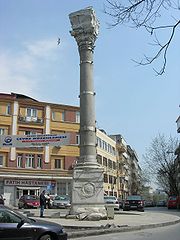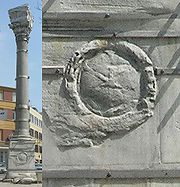
Column of Marcian
Encyclopedia


Constantinople
Constantinople was the capital of the Roman, Eastern Roman, Byzantine, Latin, and Ottoman Empires. Throughout most of the Middle Ages, Constantinople was Europe's largest and wealthiest city.-Names:...
in 455
455
Year 455 was a common year starting on Saturday of the Julian calendar. At the time, it was known as the Year of the Consulship of Valentinianus and Anthemius...
dedicated to the Emperor Marcian
Marcian
Marcian was Byzantine Emperor from 450 to 457. Marcian's rule marked a recovery of the Eastern Empire, which the Emperor protected from external menaces and reformed economically and financially...
. It is made of red-grey Egypt
Egypt
Egypt , officially the Arab Republic of Egypt, Arabic: , is a country mainly in North Africa, with the Sinai Peninsula forming a land bridge in Southwest Asia. Egypt is thus a transcontinental country, and a major power in Africa, the Mediterranean Basin, the Middle East and the Muslim world...
ian granite
Granite
Granite is a common and widely occurring type of intrusive, felsic, igneous rock. Granite usually has a medium- to coarse-grained texture. Occasionally some individual crystals are larger than the groundmass, in which case the texture is known as porphyritic. A granitic rock with a porphyritic...
, in two pieces. The basis is quadrilateral
Quadrilateral
In Euclidean plane geometry, a quadrilateral is a polygon with four sides and four vertices or corners. Sometimes, the term quadrangle is used, by analogy with triangle, and sometimes tetragon for consistency with pentagon , hexagon and so on...
, formed by four slabs in white marble
Marble
Marble is a metamorphic rock composed of recrystallized carbonate minerals, most commonly calcite or dolomite.Geologists use the term "marble" to refer to metamorphosed limestone; however stonemasons use the term more broadly to encompass unmetamorphosed limestone.Marble is commonly used for...
, decorated with Chi-Rhos inside medallions on three faces, and two genii
Genius (mythology)
In ancient Roman religion, the genius was the individual instance of a general divine nature that is present in every individual person, place or thing.-Nature of the genius:...
(who account for the Turkish name of the column) holding a globe
Globe
A globe is a three-dimensional scale model of Earth or other spheroid celestial body such as a planet, star, or moon...
. The column is topped by a Corinthian capital (decorated with aquila
Aquila (Roman)
The Aquila was the eagle standard of a Roman legion, carried by a special grade legionary known as an Aquilifer. One eagle standard was carried by each legion.-History:...
s) probably a basis for a statue of Marcian in imitation of the Column of Trajan and the Column of Marcus Aurelius
Column of Marcus Aurelius
The Column of Marcus Aurelius is a Roman victory column in Piazza Colonna, Rome, Italy. It is a Doric column featuring a spiral relief: it was built in honour of Roman emperor Marcus Aurelius and modeled on Trajan's Column.- Construction :...
in Rome, which definitely were topped by statues of the emperor they commemorated.
There is an inscription engraved on the northern side of the basis. The engraved inscription was originally topped with bronze, but it has since been removed. The inscription reads:
Principis hanc statuam Marciani | cerne torumque
praefectus vovit quod Tatianus | opus
(Observe this statue of the princeps Marcian and its base,
a work dedicated by the prefect Tatianus.)

